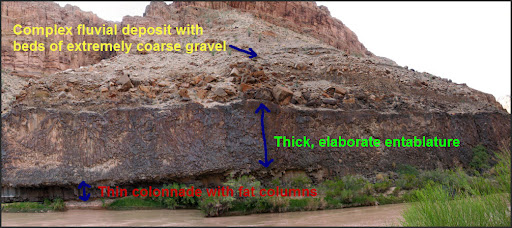- Lava flow on river gravel; no evidence for water interaction other than flowing down the channel.
- Flagrant flow morphology characterized by relatively thin colonnade (with very fat columns in the example below) overlain by considerably thicker entablature.
- Coarse-grained, complex fluvial deposit containing abundant reworked lava and hyaloclastite material.
Here is a 'Grand' example from mile 192:
 What might be going on here? Well, following some discussion with Ryan Crow and some reading about entablature formation that he recommended, I think that this assemblage permits the following interpretation:
What might be going on here? Well, following some discussion with Ryan Crow and some reading about entablature formation that he recommended, I think that this assemblage permits the following interpretation:- Lava flow enters canyon and blocks river, allowing flow to continue unimpeded downstream (lava on gravel with no evidence for lava-water interaction)
- Clear water begins to pass over or through the dam (or both) and greatly accelerates cooling of the lava (induces the elaborate and thick entablature structure)
- Dam eventually (soon) fails catastrophically and coarse gravel is deposited on the lava flow that now forms the bed of the river.
With respect to the distinct morphology of the cooling structure of the lava flow, it seems almost inevitable that the very thick and elaborate colonnade reflects the influence of rapid cooling of the lava flow by a very large volume of water. In this case, I am inferring that this huge amount of water is the continuous, initially clear flow of the Colorado around, over, or through the dam. It is also notable that the overlying deposit is multi-phased. There are several beds and only some are extremely coarse. The sequence may contain evidence for the progressive failure of the dam and other vagaries of the hydrograph.
It would be interesting to know if there was any evidence that the gravels were deposited on a cooling lava flow...maybe there are some key erosional forms to look for. Didn't think of that at the time.
This seems like a strong case for failure of a lava dam. There are no assemblages like this on the Owyhee River.
Check this abstract for a discussion of the role of water in forming the colonnade:

Here are some other articles of interest (from a longer list compiled in 5 minutes using Zotero)
Grossenbacher, K. A., and S. M. McDuffie. “Conductive cooling of lava: columnar joint diameter and stria width as functions of cooling rate and thermal gradient.” Journal of Volcanology and Geothermal Research 69, no. 1-2 (1995): 95-103.
Long, P. E., and B. J. Wood. “Structures, textures, and cooling histories of Columbia River Basalt flows.” Bulletin of the Geological Society of America 97, no. 9 (1986): 1144-1155.
Lyle, P. The eruption environment of multi-tiered columnar basalt lava flows. Vol. 157. Geological Soc London, 2000.
Walker, G. P. L. “Basaltic-volcano systems.” Geological Society London Special Publications 76, no. 1 (1993): 3.

No comments:
Post a Comment
Note: Only a member of this blog may post a comment.